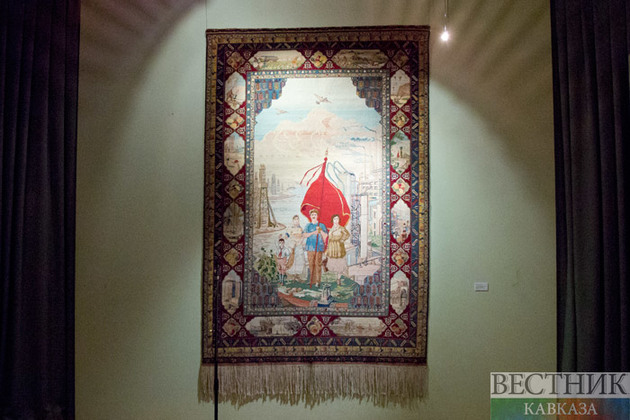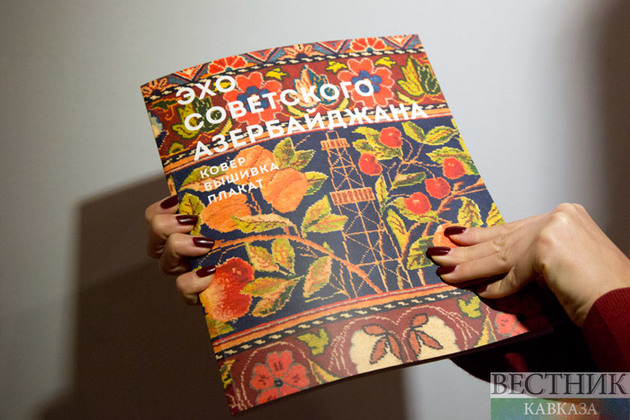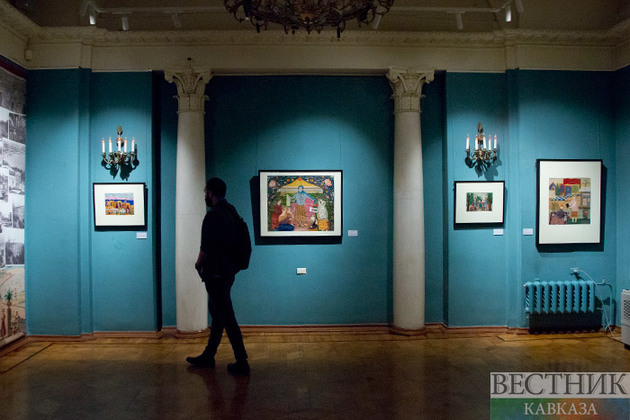'The Echo of Soviet Azerbaijan. Carpet. Fancywork. Poster' exhibition was organized at the State Museum of Oriental Art with the support of the Russian and Azerbaijani Ministries of Culture, the Heydar Aliyev Foundation’s representative office in Russia, the Azerbaijani Embassy in Moscow and the Azerbaijan National Carpet Museum. Director of the museum Shirin Melikova told Vestnik Kavkaza about the exhibition and the carpets.
- That's not your first collaboration with the Museum of Oriental Art, is it?
- We have been holding exhibitions together with the State Museum of Oriental Art for the second year. This time we are moving from the ornamented, aesthetic space of a traditional Azerbaijani house of the late 19th century, which was shown in April 2019, to a new era. This is the Soviet era, 1920-1970s.
This year we present exhibits from the collection of the Azerbaijan National Carpet Museum, from the collection of the State Museum of Oriental Art, and posters from the collection of the Mardjani Foundation. Many of these exhibits are on display for the first time. And the whole composition it is an unprecedented project.
The Soviet period is well represented in our collection. We brought here monumental, luxurious rugs that reveal all the day-to-day activities, leisure activities of Soviet people.

- What is the difference between the carpets of the Soviet era from the traditional ones?
- The carpet art developed at all times, preserving its canons, traditional forms. We see traditional compositions in these carpets. Azerbaijani carpets are based on clear symmetry, the rhythm of both composition and color. Several border stripes surround the central field. These are medallions and cartouches. All these elements of the Azerbaijani carpet, including a luxurious ornamental culture, were preserved during the Soviet era, being transformed and getting new ornamental forms.

The novelty of the Soviet era was carpets telling stories, which are closely related to the great style of that era. And the leading artists of that time took part in the creation of these very picturesque compositions. Carpets have always been closely associated with the work of outstanding artists of that time. When we talk about the Safavid period, this is Sultan Mohammad. When we talk about the Soviet era, this is Latif Karimov - the number one expert on oriental carpet in the world, the initiator of creating the world's first carpet museum, our National Carpet Museum in Baku, the author of the fundamental work 'Azerbaijan Carpet', which is an Azerbaijani carpet encyclopedia to this day. He was also a weaver and designer, he headed the "Azerkhalcha" - a production association with its own artels throughout the republic established in 1927. Being the main artist, Latif Karimov became, one might say, the author of the Soviet carpet. Not only ornamental painters, but also outstanding painters of that era were on his team. Since the 1930s, these were Azim Azimzadeh, then Salam Salamzadeh, Mikayil Abdullayev, Kazim Kazimzade, Gazanfar Khalykov and other artists. Their paintings were remarkably translated to the carpet language.

All these huge carpets were created by special state order. The largest carpet in our collection depicts Lenin. This carpet is 10x7m, it has 37 million knots. Can you imagine how hard it was to make it! This exhibit is stored at the Carpet Museum, we do not show it in Moscow, as it's very difficult to transport it.
We are very happy that now we present these Azerbaijani carpets in Moscow, especially since the exhibition is held in honor of the 10th anniversary of the inclusion of the Azerbaijani carpet in the UNESCO List of the Intangible Cultural Heritage of Humanity.
- On what basis was the exhibition formed?
- Behind me there is a wonderful 1969 'Oil workers' carpet. Here we see the traditional composition peculiar to the Azerbaijani carpet. There is no medallion, but there is a central plot composition, that depicts people of a new formation. These are an oil worker, a collective farmer, a pioneer, a free woman who has took off her veil and received her education. I think that she is an engineer - the builder of a new life.

We see this global picture against the backdrop of an industrial landscape. This is also a symbol of this progressive era - airplanes in the sky, the developing oil industry. Cartouches depict historical monuments, the historical heritage of Azerbaijan, as well as various industries, fishing, leisure of an Azerbaijani family. But the most interesting thing is that a rhythmically repeating ornament depicting an oil pipeline is inscribed in its small border. This is a completely new detail that fits into the language of a traditional carpet. We wanted to talk about this, raise this issue. After the Soviet Union collapsed, many exhibits that bear the mark of that era are not shown in permanent compositions. They are on display in our museum, but they are mainly stored in collections, unfortunately, they are little studied. Many people experience mixed emotions about it; many see only ideological aspects in it.
- Why did you take a risk?
- I do not think that that was a risk. We are art experts, art historians, we study the developmental stages of various types of art, in this case I mean the most traditional types of art. These are artistic embroidery and carpet, which, it would seem, should be less susceptible to all kinds of revolutions, but nevertheless we see that even these forms of art were used for certain ideological propaganda purposes during the Soviet era. Now we don’t perceive them like that. We perceive them as works of art, because they are, which is quite obvious.
Many kinds of applied art were lost when the Soviet Union collapsed, when the picture of life, the way of life changed, when spiritual values shifted. Now we are reviving lost crafts. But the development of the carpet, a symbol of Azerbaijan, has never stopped. Throughout our people's history, the Azerbaijani carpet has always been a mirror of its era, as well as the wonderful carpets and embroideries from the Museum of Oriental Art.































